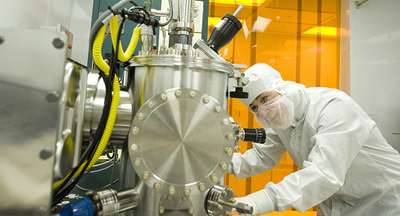Engineers Demo Smallest Room Temperature Laser

(PhysOrg.com) -- Imagine packing 4 billion nanolasers on a three-inch semiconductor wafer. That is now nearer to reality, thanks to researchers at the University of California, San Diego’s Jacobs School of Engineering, who have demonstrated a micron-sized laser - less than one-thousandth of a millimeter on each side - that can operate at room temperature.
Until now, the only way to operate such a nanolaser was to cool it cryogenically to offset the various losses in the device. The UCSD solution, as published online in advance of appearing in the May issue of the journal Nature Photonics, was to add super-thin layers of silica (glass) and aluminum to encase the core of each device.
“Shrinking the size of lasers to below their wavelength of emission has been challenging historically,” said Yeshaiahu (Shaya) Fainman, principal investigator on the project and a Cymer professor in UC San Diego’s Electrical and Computer Engineering (ECE) department. “What we have developed is a laser measuring one micron or less in all three dimensions - height, width and depth - that emits a beam with a wavelength of approximately 1.4 microns. These devices are truly ‘subwavelength,’ because they are smaller than the wavelength of light they emit into air.”
In theory these nanolasers could be packed densely on a wafer because the metallic aluminum layer helps to avoid coupling between neighboring nanolasers and also helps to conduct and dissipate the heat generated in the lasing process. “Using the aluminum shield gives the device superior heatsinking properties, which is important for device operation,” added Fainman. “Using the metal shield confines the optical mode, so that two or more lasers can be placed very close to each other without interfering with each other's operation.”
“Commercial applications of the technology are at least two years away,” noted Maziar Nezhad, first author of the paper and an assistant project scientist in UC San Diego’s ECE department. “But we also foresee its use in dense arrays of surface-emitting lasers for optical interconnects. The process could also be applied to the design of lasers for imaging in the far infrared range of the spectrum, due to the improved optical properties of metals in the infrared range.”
To achieve a subwavelength laser, Nezhad and his colleagues in Fainman’s Ultrafast and Nanoscale Optics Group worked through a series of approaches to create an efficient subwavelength cavity. The conventional approach used in the past for this purpose had been to use a fully dielectric cavity, but it quickly became evident that in the subwavelength size regime this type of cavity would not lead to a working solution. The UCSD team decided to incorporate a metal/dielectric composite layer in the nanolaser design to create an efficient resonant cavity and also to electromagnetically isolate the nanolaser from surrounding devices. The immediate candidates for the metal to be used - aluminum, gold and silver - all have good optical properties because they are very reflective (i.e., they absorb less light). In the tests described in the Nature Photonics article, aluminum was used, but Nezhad says that in theory, silver should be the most efficient shield.
The fabrication was done in the Nano3 clean room facility of the California Institute for Telecommunications and Information Technology (Calit2) at UC San Diego. To create and characterize the tiny lasers with their composite layers of glass and aluminum, the team made extensive use of Nano3’s electron beam lithography, etchers, deposition tools, scanning electron microsocopy and optical profiling equipment. Once the wafers of micron-sized laser cavities were complete, optical measurements were performed in Fainman’s lab in the Jacobs School of Engineering.
The researchers point out that it is of paramount importance to control the thickness of the glass layer. “If you don’t put this glass layer around it, the metal would be too close to the optical field, and there would be too much interaction between the metal and the field and the cavity losses would be too high,” explained Nezhad. “On the other hand, a glass layer that is too thick would result in a device that is either too large or has too little active semiconductor material -- reducing its efficacy. Through careful design, fabrication and testing, we found an optimal balance that created a room temperature laser that emits an infrared beam with a wavelength that is larger than the overall device dimensions.”

The team at UC San Diego is one of seven around the country funded by DARPA through its Nanoscale Architectures for Coherent Hyper-Optic Sources (NACHOS) program. The program aims to create nanoscale lasers that “will enable close integration of photonic and electronic devices needed in emerging high-speed, processing-intense computing and communication platforms. In addition to reduced size, these lasers are expected to be power efficient and offer unprecedented modulation bandwidth. New capabilities, such as the ability to place large numbers of lasers on silicon chips, will be enabled by these devices.”
While other NACHOS-funded teams were mainly working on solutions at cryogenic temperatures, UC San Diego focused on delivering an optically-pumped laser operating in pulse mode at room temperature - which it delivered last summer. In the ongoing Phase Two of the project, the research teams are working on replacing the optical pump with electrical pumping (also known as injection pumping) and by the end of the five-year program’s final phase in 2012, the research teams are expected to demonstrate nanolasers operating in continuous rather than pulsed mode.
“With an optical pump, an external laser comes in at one wavelength and you excite the gain medium and then collect the light at the lasing wavelength. This requires a fairly large and complicated optical setup,” explained Nezhad. “But if we can achieve these goals with an electrical pump, instead of relying on an external laser, you would only need a tiny power source to fuel the laser.”
Looking ahead, principal investigator Shaya Fainman says the program at UC San Diego aims to accomplish DARPA’s roadmap on time or ahead of schedule. “Making electrically pumped arrays of these lasers is one approach we are already working on, and we will also look at replacing aluminum with silver because of its unique optical properties,” said the Calit2-affiliated scientist. “Another challenge will be to show that the properties of this micron-sized laser will hold up as we pack more and more lasers on a wafer.”
Meanwhile, the teams at other universities are working on their own solutions to the challenges set forth by DARPA, so the researchers at UC San Diego won’t be resting on their laurels.
More information: "Room-temperature subwavelength metallo-dielectric lasers", Maziar P. Nezhad, Aleksandar Simic, Olesya Bondarenko, Boris Slutsky, Amit Mizrahi, Liang Feng, Vitaliy Lomakin & Yeshaiahu Fainman. Nature Photonics, Advance Online Publication, 18 April, 2010. Published online: 18 April 2010. doi:10.1038/nphoton.2010.88
Provided by University of California - San Diego


















